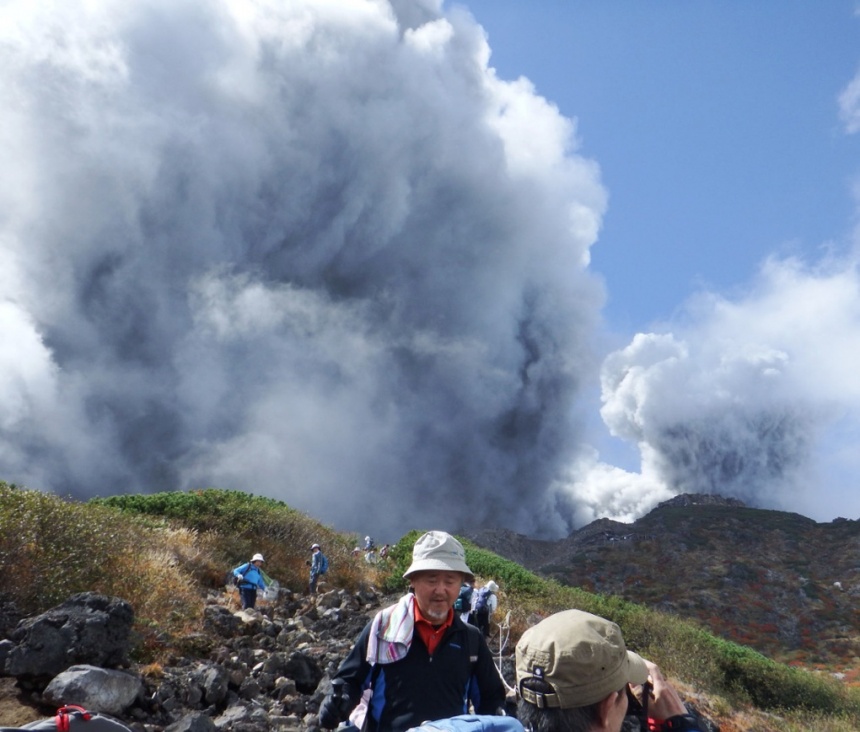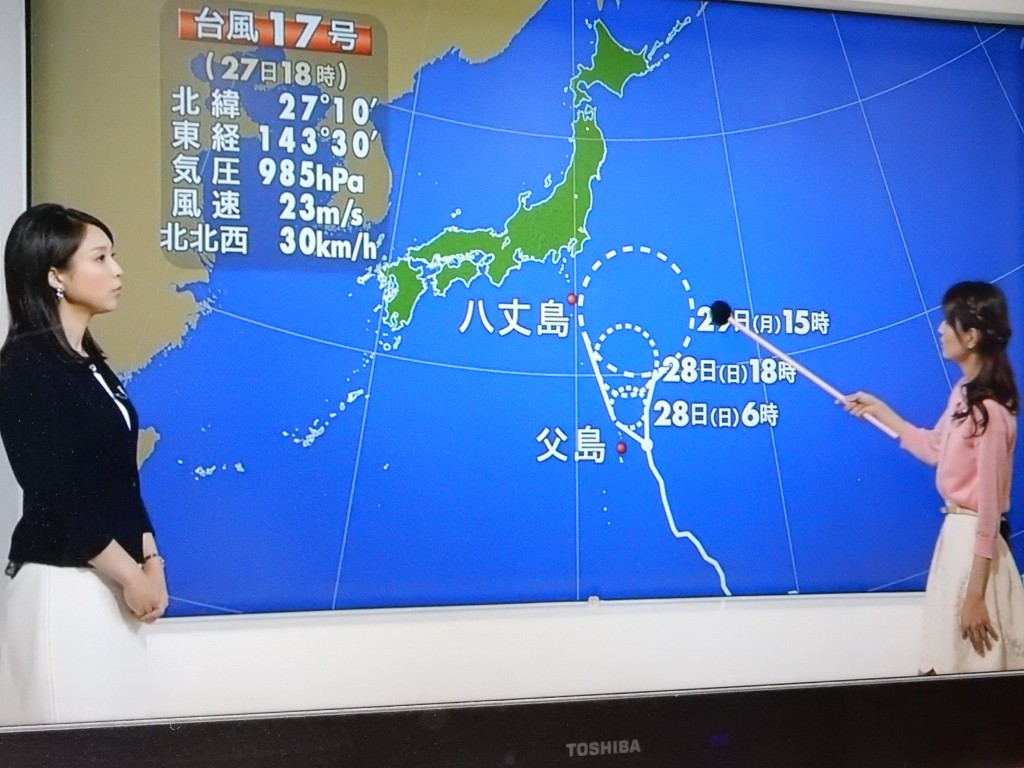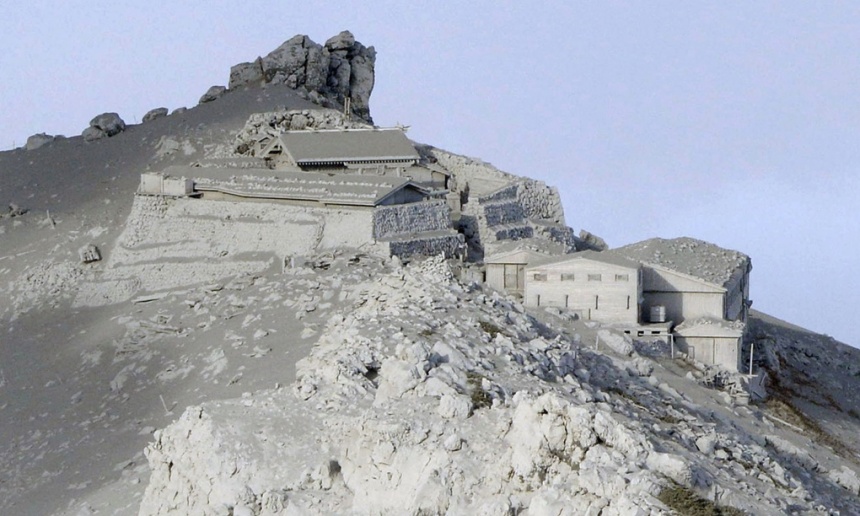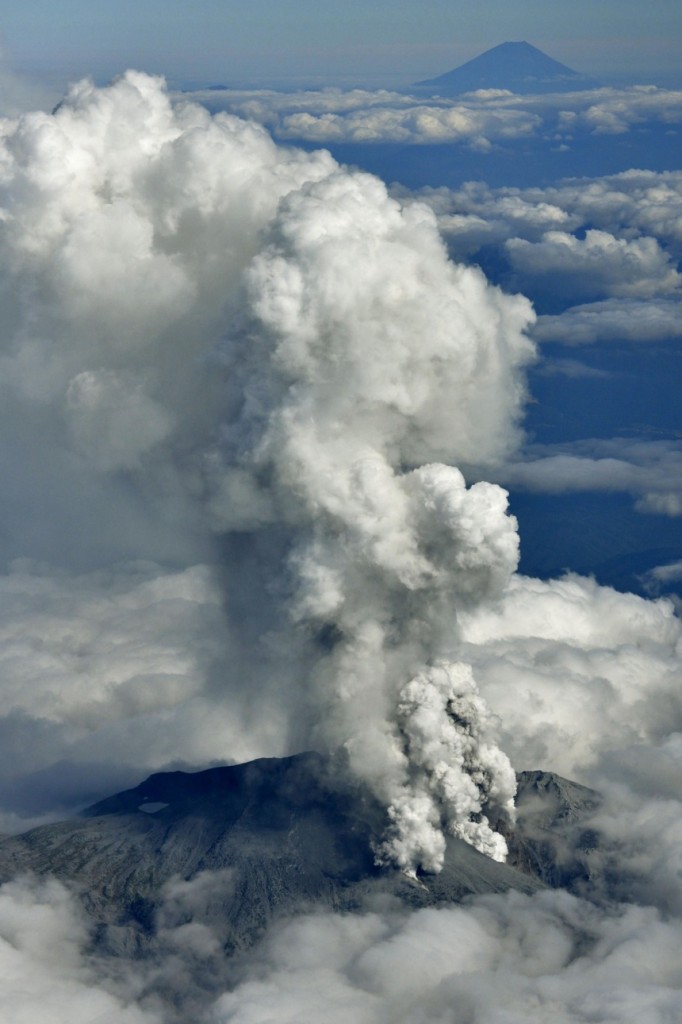
The kami of Mt Ontake blows its top (anonymous photographer via Kyodo News)

Meanwhile, a typhoon is approaching Japan, as seen here on the weather forecast
Mt Ontake, Japan’s second tallest volcano at 3067 meters (1062 ft), has erupted with dozens stranded or injured. (The Guardian has a short video of the eruption with a statement by prime minister Abe here.)
Unfortunately, because it was a beautiful sunny weekend in early autumn, there are thought to have been hundreds on the mountain at the time of the eruption. The volcano which sits on the border of Gifu and Nagano prefectures is a sacred mountain, where shamanistic practices have long been carried out. These include artists and actors entering a meditative trance to get divine inspiration.
It’s often said that one of the formative features of Shinto is its cultivation in a land of disasters. Earthquakes, volcanoes, typhoons and tsunami are common events. In the face of this the Japanese developed a ‘shikata ga nai‘ (it can’t be helped) stoicism. They also developed a religious practice of placating the kami which visited such disasters upon them. There was little thought of morality in this, but rather an awareness that kami have a rough side (aramitama) and a soft side (nigimitama).
Wikipedia carries this useful explanation of the differences:
The ara-mitama is the rough and violent side of a spirit. A kami’s first appearance is as an ara-mitama, which must be pacified with appropriate pacification rites and worship so that the nigi-mitama can appear. The nigi-mitama is the normal state of the kami, its functional side, while the ara-mitama appears in times of war or natural disasters.
These two souls are usually considered opposites, and Motoori Norinaga believed the other two to be no more than aspects of the nigi-mitama. Ara-mitama and nigi-mitama are in any case independent agents, so much so that they can sometimes be enshrined separately in different locations and different shintai (spirit-bodies).
For example, Sumiyoshi Shrine in Shimonoseki enshrines the ara-mitama of the Sumiyoshi kami, while Sumiyoshi Taisha in Osaka enshrines its nigi-mitama. Ise Shrine has a sub-shrine called Aramatsuri-no-miya enshrining Amaterasu’s ara-mitama. No separate enshrinement of the mitama of a kami has taken place since the rationalization and systematization of Shinto actuated by the Meiji restoration

Mountain lodge covered in ash on Mt Ontake

(Photo courtesy AP)

It seems they did not heed the warnings, maybe afraid of losing business at this most profitable season? Sometimes I believe some Japanese still have that kamikaze spirit about them.
Interesting observation, Hugo. There are many Japanese who themselves think that the kamikaze pilots embodied the true spirit of Japan (and of Shinto?).
It’s really a tragedy at Mt. Ontake. 31 dead so far, hopefully that number doesn’t rise any higher.
About nigi-/ara-mitami, I believe that Wikipedia’s explanation that “The nigi-mitama is the normal state of the kami, its functional side, while the ara-mitama appears in times of war or natural disasters” is overly simplistic. Both sides are certainly functional; in fact it would be easy to argue that the aramitama is more “functional”, since that’s the one associated with outward expressions of action!
It’s also worth remembering that this is not necessarily some arcane Shinto doctrine; the concept of the soul (and the world) existing as a balance of opposing forces of “male/outward/aggressive” and “female/inward/passive” which together form one whole is hardly limited to Japanese thought. Indeed, the obvious similarity in form between the comma shape of traditional Shinto magatama jewels and the yin-yang motif of Chinese philosophy is striking and often commented on.
Thank you, Quin, for the input. My understanding is that there were originally several aspects of the soul, as in Siberian shamanism. These appear to have been simplified in essence to the yin-yang aspects you mention, though I’m not sure that was how they were conceived. Of course they do sit easily with Jungian psychiatry and other modern notions, which makes it all the more surprising the practice of enshrining the different aspects has been dropped since Meiji times.
By way of an update, as of October 12, 2014 the number of confirmed dead has risen to 56. I believe a number of others are still missing…
Best not go near the issue of kamikaze, things can get awfully sticky awfully fast…
The Meiji era of course saw Japan consciously adopt many Western models, but being pre-Jung it’s not surprising that they missed that particular correspondence! There does seem to be at least a little bit of awareness of nigi-/ara-mitama among some lay Shinto practitioners today; who knows, perhaps the fashion might come into play again at some point in the future. As for the original conception of nigi-/ara-mitama, that’s probably lost to the mists of time.
The ichirei shikon (“one soul/four spirits”) model I believe you are referring to (via the Wikipedia article?) is indeed fascinating, and as you point out, has counterparts in other cultures. Another that springs to mind is the common multicultural concept of a personal guardian angel or guardian spirit. In fact, that’s how Aston translates the mysterious passage of the Nihongi where Onamochi (a.k.a. Okuninushi) where the deity meets another aspect of his own soul.
From Aston’s Nihongi, I.60-61:
Therefore he said finally: — ‘It is I, and I alone, who now
govern this Land. Is there perchance any one who could
join with me in governing the world?’ Upon this a Divine
radiance illuminated the sea, and of a sudden there was
something which floated towards him and said: –‘Were
I not here, how couldst thou subdue this Land? It is
because I am here that thou hast been enabled to
accomplish this mighty undertaking.’ Then Oho-na-
mochi no Kami inquired, saying: –‘Then who art thou?’
It replied and said: –‘I am thy guardian spirit, the
wondrous spirit.’ Then said Oho-na-mochi no Kami:
–‘True, I know therefore that thou art my guardian spirit,
the wondrous spirit.”
Unless I’m mistaken, though– and I’d happy to be shown to be so, as the implications would be fascinating to me– the pre-Meiji era habit of enshrining specific mitama/soul parts was specifically limited to the nigi-mitama and ara-mitama. I have visited several shrines which particularly mention enshrining nigi-mitama or ara-mitama, but none which I was aware of enshrining saki-mitama (happy/lucky spirit) or kushi-mitama (mysterious/wondrous spirit).
Thanks for the input, Quin. It’s a good point about the enshrining…. it does seem to be restricted to two spirits rather than four. The idea of meeting another aspect of one’s own soul is fascinating and makes me think of mirrors and Doubles…. I wonder if the many names of kami in Japanese myth are referring to different souls somehow…
Hi John. From this post and the related comments I see that I still have much to learn about Shinto! That’s why your blog is so interesting and informative. I’ve come across one soul/ four spirits, but not the two sides of the kami and their enshrinement. It brings me back to the very elemental setting that Japan finds itself in, a land of earthquakes, typhoons, volcanoes, tsunamis and the like. Cultures commonly display a love/hate relationship with the elements – in the west they are often called friend or foe (recently focusing more on the latter). The two sides of the kami could reflect this relationship as well. Or I could be completely off the mark!
Hi Jann… friend or foe refers to benign/bountiful versus hostile/destructive? What’s interesting about nature worship is that much of it is selective in choosing pretty pictures of green fields, sunsets and wild flowers etc. I think that comes from our comfortable perspective, removed as we are for the most part from the real world. But nature in the raw is as we know from David Attenborough horrifyingly cruel and often far from pretty. In fact, it seems to have been the destructive side rather than the beauty of nature that prompted much early worship. Placating angry kami was often the impulse behind early festivals, for instance.
Benign/bountiful versus hostile/destructive is spot on John when describing friend or foe. I’ve just received a book called ‘birthright’ by Stephen Kellert that discusses both the aversion and affection that humans have towards nature. He argues that both are critical for human health and well-being. So the early worshippers may have got it about right – on the one hand being wary of the destructive side of nature and try and appease it through worship/festivals, and on the other hand enjoying the beauty in natural phenomena such as a colourful sunset or full moon.
That’s quite an interesting thought. My own not-too-serious hypothesis is that a god with a lot of different names, and each chapter of their story with a new name, might indicate different lifetimes in a cycle of incarnations. After all, Okuninushi, who is explicitly associated with magical rebirth after death, also has a particularly vast number of different names (only some of which get their own tales). It’s probably actually something much more mundanely practical, such as consolidation of the similar/same deities from different localities in a way that still honors their local names…
But that’s the thing about myths. Always room for another interpretation. :-)